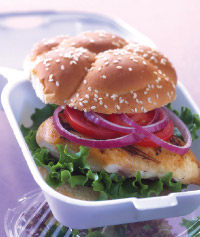Saying no to styrofoam
by Ellie Rose
This article was originally published in April 2007

(April 2007) — I have no prior experience in environmental activism, but after reading a paragraph in the “Newsbites” section of the August 2006 Sound Consumer, I felt I had to do something. In response to spiraling environmental degradation, Oakland, Portland and other U.S. cities have banned the use of styrofoam take-out containers in restaurants and cafés.
The obvious question came to me — why not Seattle? Why would our environmentally progressive city not choose to use readily available biodegradable and compostable alternatives to this deleterious plastic?
I started by making phone calls to the Sound Consumer editor for sources on the Newsbite story, and then to nonprofits and individuals, trawling for interest in organizing a ban campaign. The response was surprising. Nobody needed to be sold the idea — they already were enthusiastic and a number of them readily volunteered to participate. City council staff was receptive when contacted about the initiation of such an effort. The Internet was rich with research and articles on known hazards of polystyrene use. Assembling a working team came together almost effortlessly. Our consensus was: if Portland, Ore., can do it, then so can Seattle!
Why would our environmentally progressive city not choose to use readily available biodegradable and compostable alternatives to this deleterious plastic?
We decided to call our group Foam-Free Seattle. We set to work eagerly, beginning with reviewing the research.
Polystyrene exists in our environment for hundreds or thousands of years because it does not biodegrade. Instead, it “photodegrades,” meaning sunlight breaks it into progressively smaller pieces, literally too small to measure by any available means.
Similar in size to and more abundant than plankton, tiny pieces of polystyrene are consumed by filter feeders, which in turn are eaten by animals higher on the food chain, such as fish, birds and sea mammals, leading to bioaccumulation.
A U.S. Environmental Protection Agency National Human Adipose Tissue Survey for 1986 identified styrene residues in 100 percent of all samples of human fat tissue. According to a Foundation for Achievements in Science and Education fact sheet, “Longterm exposure to small quantities of styrene can cause neurotoxic (fatigue, nervousness, difficulty sleeping), hematological (low platelet and hemoglobin values), cytogenetic (chromosomal and lymphatic abnormalities), and carcinogenic effects.”
Due to human littering, urban runoff and redistribution by storms and wind, ultra-light polystyrene cups, clamshells, packing peanuts and other products end up in waterways and the ocean. All sorts of floating plastics, including tiny broken-up bits of polystyrene, cover areas in the Pacific Ocean roughly the size of Texas.
The California Department of Transportation conducted a litter management study during 1998-2000 and found polystyrene foam represented 15 percent of the total volume of litter recovered from storm drains. In Seattle, we spend hundreds of thousands of dollars each year on litter cleanup. With the tendency of polystyrene to break into smaller and smaller pieces, cleanup is difficult and therefore more costly. Even properly disposed of, polystyrene easily blows out of trash receptacles, landfill sites and sanitation trucks.
In Washington state we don’t have the capacity to recycle polystyrene. In states where recycling is an option, there are significant problems of contamination of styrofoam by food residues.
Polystyrene already is banned to various degrees in as many as 100 other jurisdictions, including Orange County, Calif; Suffolk County, NY; Santa Monica, Calif; Malibu, Calif; Portland, Ore; San Francisco, Calif., and Freeport, Maine. Foam-Free Seattle is planning on putting together a ban “template” for concerned communities in other cities so the groundwork for new campaigns doesn’t need to be recreated by each group.
We had 13 community members turn out for the Foam-Free Seattle kick-off meeting in January. We discussed review findings, strategies, networking, outreach and assignment of research tasks.
We’re looking into alternatives to polystyrene already in use in areas where bans are in place. This includes “mom and pop” operations as well as large national chains such as McDonalds and Taco Bell. A number of local businesses already have eschewed the use of polystyrene; The Essential Baking Company, Ivar’s, Silence-Heart-Nest, Madison Market, Café Flora and others already are foam-free. Most use paper instead.
PCC also is foam-free, except for meat trays and the merchandiser is looking at alternatives. (The PCC delis also are planning to introduce either a completely biodegradable potato starch- or sugar cane-based alternative “plastic” — for instance, a coffee cup lid — as a test item soon.)
Foam-Free Seattle is scheduled to meet with representatives of the Mayor’s Office and Seattle Public Utilities to discuss the proposed ban. We’ll present information we have collected and provide staff with copies of ordinances from other cities.
It’s energizing to see how individual citizens, pooling our strengths and areas of expertise, can forward the possibility of a sustainable future. We welcome you to join the effort.
For more information, or to attend the next meeting of Foam-Free Seattle, visit our new Web site at www.foamfreeseattle.org.
Ellie Rose is a PCC member who may be found shopping at PCC Fremont or Greenlake.
